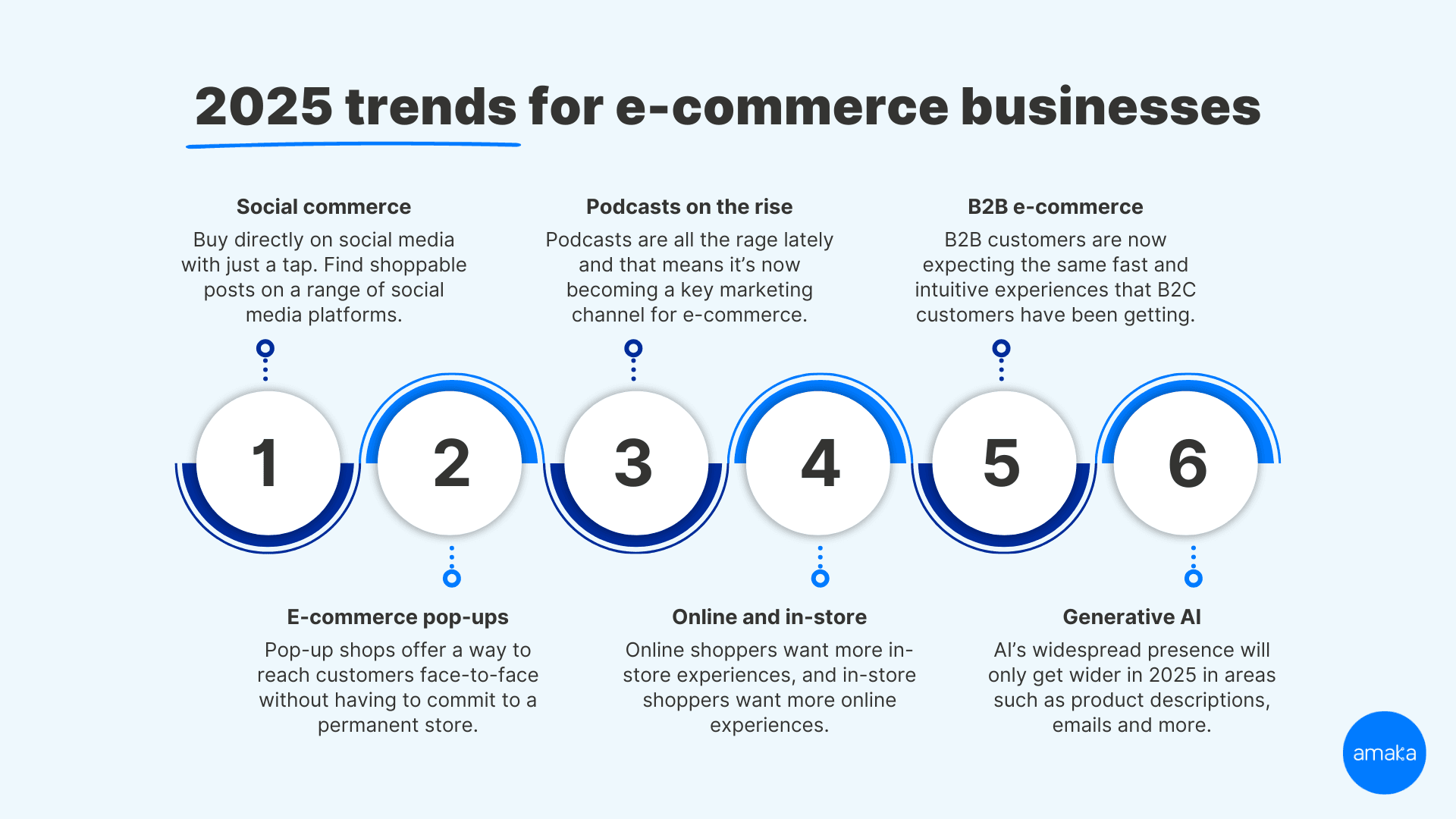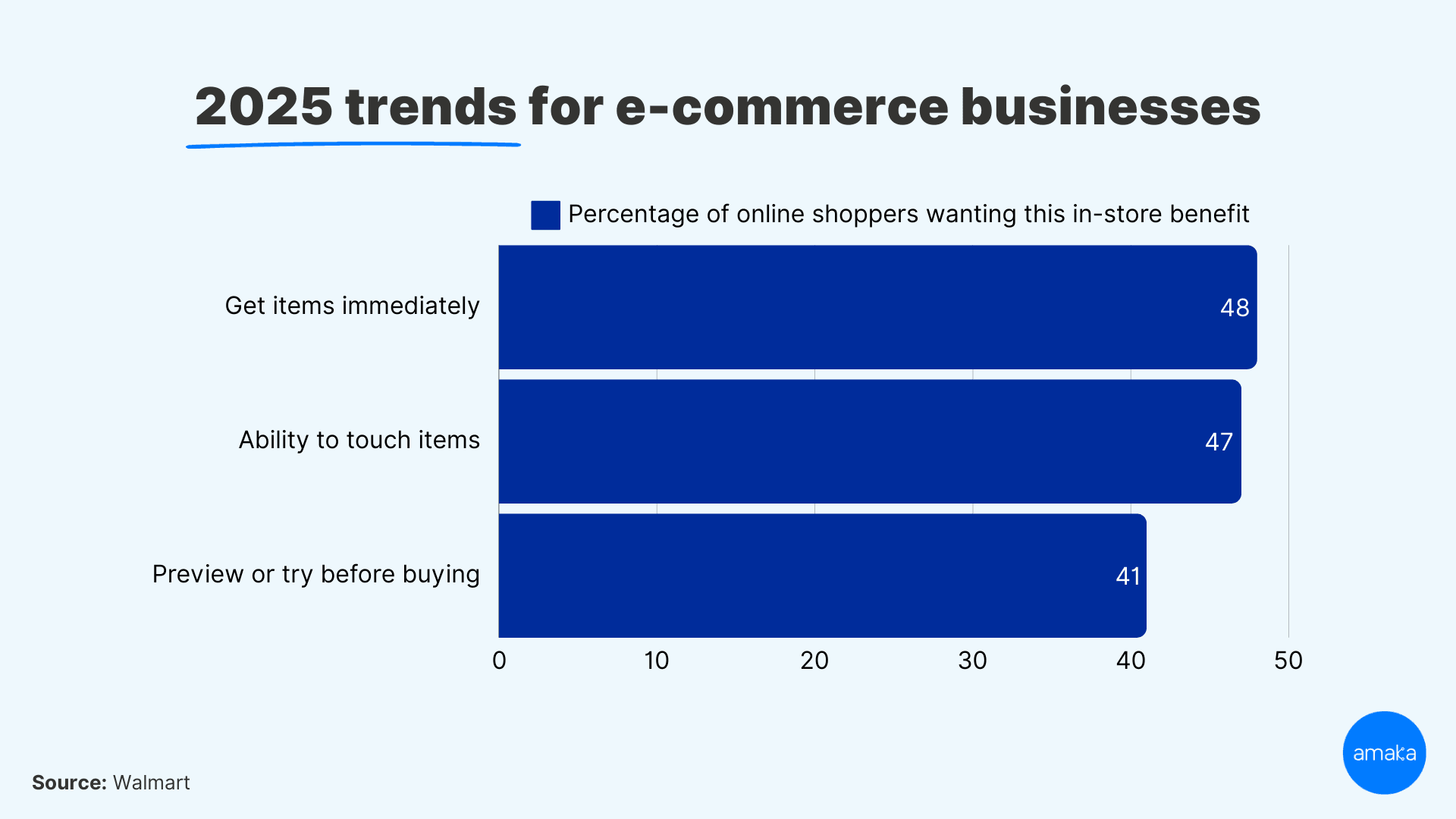E-commerce trends 2025: Growth projections, forecast and statistics
E-commerce trends in 2025 are proving that the landscape continues to evolve at a rapid pace. Growth projections indicate that the market is still on an upswing. In this article, we’ll go through the latest research e-commerce businesses need to be aware of to maintain a competitive advantage.
We’ll be going through a general forecast as well as specific trends. For example, the rise of social commerce, e-commerce pop ups and podcasts. Additionally, we’ll discuss how existing trends such as omnichannel experiences, B2B e-commerce, AI and customer experience are shifting.
Growth projections for global e-commerce in 2025
According to recent e-commerce statistics gathered by Shopify, global e-commerce sales is expected to grow from USD $6.09 trillion in 2024 to USD $6.56 trillion in 2025 (a growth of 7.8%). The current leaders in the market as of October 2024 are China, United States, Japan, United Kingdom and Germany.
According to EMARKETER, Gen Z is leading the rise in e-commerce sales. Where other generations are expected to have mostly stagnant growth, Gen Z numbers are expected to grow from 46 million last year to over 61 million in 2027 in the US alone. Plus, with more Gen Z entering the workforce in coming years, spending power will only increase.

Social commerce: Buy directly on social media with just a tap
Social media is becoming more than just a marketing channel and is increasingly facilitating shopping experiences. You’ll now find shoppable posts on platforms like Instagram, Facebook, YouTube, Pinterest and TikTok. There are even some integrated checkout systems to allow customers to complete a purchase without having to leave the platform.
Recent research on worldwide online purchases by Statista found that 16.6% of e-commerce purchases in 2024 were made through social media and is expected to grow to 17.1% in 2025. On top of that, 43% of consumers use social media to browse goods and services before buying. E-commerce businesses will need to prioritise social media as both an awareness tool and as a sales channel.
E-commerce pop-ups: The new digital and physical hybrid
Pop-up shops offer e-commerce businesses a great way to reach customers face-to-face without having to commit to a permanent brick-and-mortar store. Research on pop-up shops by CapitalOne Shopping suggests that they will generate up to $80 billion in annual revenue this year with projections indicating that this will exceed $95 billion in 2025.
Typically, pop-up stores are used to raise brand awareness, improve rapport or introduce a new product. Depending on what you sell, it can give customers the chance to try before they buy. Additionally, pop-up stores can be combined with an event or be an opportunity to experiment with different offline strategies.
On average, a pop-up shop will be active for 3 to 14 days and costs less than $5,000 to open for around 44% of businesses. Hence, the barrier to entry and level of risk can be quite low. On top of that, around 80% of retailers that have done a pop-up shop have considered it a success.
Podcasts on the rise: Audio is reshaping marketing
Podcasts are all the rage lately and that means it’s now becoming an essential marketing channel for e-commerce businesses looking to get ahead of trends. The latest consumer research by GWI shows that podcasts now beat radio in preferred audio content. It’s only beaten by music playlists and music top charts.
But how does this translate to advertising success? The same research shows that Gen Z in particular are discovering brands and products through podcasts over other channels. Comparing 2021 to 2024, there’s been an 8% increase in ads heard on podcasts. In contrast, TV has had a 4% decrease.
Fortunately, podcasts are still a relatively affordable option considering the reach. If your brand is looking to build awareness in 2025, getting placements in relevant podcasts can help to improve ROI on marketing spend.
Online and in-store becoming one blended experience
The concept of an omnichannel presence has been around for awhile in retail. However, the idea of giving customers a unified experience when shopping online and in-store has now evolved. There’s now a growing trend of online shoppers wanting more in-store experiences, and in-store shoppers wanting more online experiences.
In a recent retail report by Walmart, online shoppers are looking to get items immediately (48%), have the ability to touch items (47%) and preview or try before buying (41%). On the flip side, in-store shoppers are looking to skip checkout lines (45%), have 24/7 access (42%) and be able to easily see all items that are in stock (28%)

Therefore, there’s more pressure for retailers to create shopping experiences that have a mix of convenience, tangibility and immediacy. To stay ahead of the curve in 2025, it’s important to create more convenient access to goods, regardless of what channel customers choose.
B2B e-commerce: The new frontier of e-commerce sales
B2B e-commerce was once known to be slow and cumbersome compared to B2C. In 2025, B2B customers are now expecting to get the same fast checkouts and intuitive experiences that B2C customers have been getting for years. According to a report on the future of B2B by Gartner, “To remain competitive, agility and seamless experiences will be essential.”
Shopify, who have traditionally been focused on B2C, have seen major growth in B2B and will be putting a greater emphasis on it. Harley Finkelstein, the President at Shopify, said, “In B2B, we continue to set new records for monthly GMV highs, with September marking our largest single month ever.
“We are positioning ourselves to keep breaking these records, especially with new enhancements … including Shopify Flow automation templates that streamline B2B workflows and improvements to tax collection and conversion tracking.”
Shopify accounting eBook
Learn how to automate your Shopify accounting and spend less than an hour on your books every month.

AI again? The buzzword we can’t ignore
We can’t do a trends article without mentioning AI at least briefly. It seems as though 2024 was the year of AI. It’s expected that AI’s widespread presence will only get wider in 2025. E-commerce businesses will be forced to strike a difficult balance between using generative AI and a personal touch for areas such as product descriptions, emails, SEO, frontend experiences, customer service, and more.
Customer experience: Always evolving, always essential
The focus on customer experience will continue to evolve in the coming year. Here a few areas of interest that are worth considering:
- Streamlined or one-click checkouts
- Fast, low-friction, mobile-first experiences
- Augmented reality (AR) and virtual reality (VR)
- Range or payment options available
- Hyper-personalization with data and AI
- Sites optimized for voice search
Key takeaways on e-commerce trends 2025
Ultimately, businesses that embrace these rising e-commerce trends in 2025 will be positioned for success. Social commerce, pop-ups and podcasts are now channels that cutting-edge brands are taking advantage of. On top of that, with omnichannel experiences, B2B, AI and customer experiences constantly evolving, it’s more important than ever that e-commerce businesses stay educated.